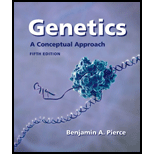
a.
To determine:
The typical eukaryotic gene and the
Introduction:
The typical eukaryotic gene consists of an exon, intron, promoter sequence, a terminator sequence, upstream sequence, downstream sequence, enhancer,and silencer. A eukaryotic gene transcribes in the m-RNA followed by protein synthesis.
a.
Explanation of Solution
Pictorial representation:
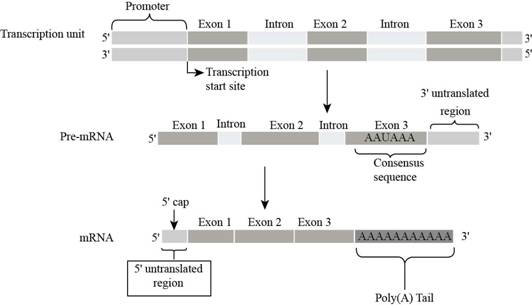
Fig.1:
RNA containsan
In the figure
b.
To determine:
The typical eukaryotic gene and the
Introduction:
The typical eukaryotic gene consists of an exon, intron, promoter sequence, a terminator sequence, upstream sequence, downstream sequence, enhancer,and silencer. A eukaryotic gene transcribes in
b.
Explanation of Solution
Pictorial representation:
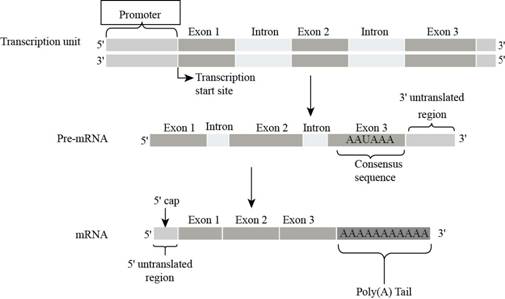
Fig. 2: Promoter.
DNA contains a promoter region in the transcription unite on which RNA polymerase binds in order to start the transcription. It is present upstream to the structural gene, and next to the transcription start site.
In the figure promoter present before the exon 1 on the DNA strand.
c.
To determine:
The typical eukaryotic gene and the
Introduction:
The typical eukaryotic gene consists of an exon, intron, promoter sequence, a terminator sequence, upstream sequence, downstream sequence, enhancer,and silencer. A eukaryotic gene transcribes in
c.
Explanation of Solution
Pictorial representation:
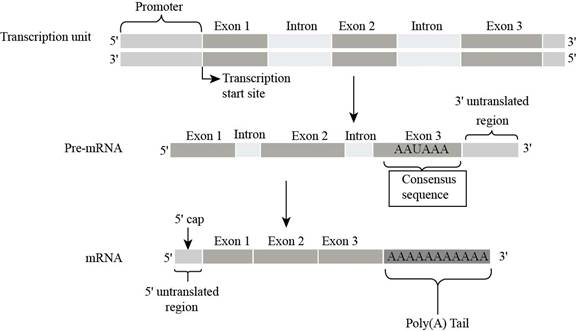
Fig. 3:
In eukaryotic
In the figure
d.
To determine:
The typical eukaryotic gene and the
Introduction:
The typical eukaryotic gene consists of an exon, intron, promoter sequence, a terminator sequence, upstream sequence, downstream sequence, enhancer,and silencer. A eukaryotic gene transcribes in
d.
Explanation of Solution
Pictorial representation:
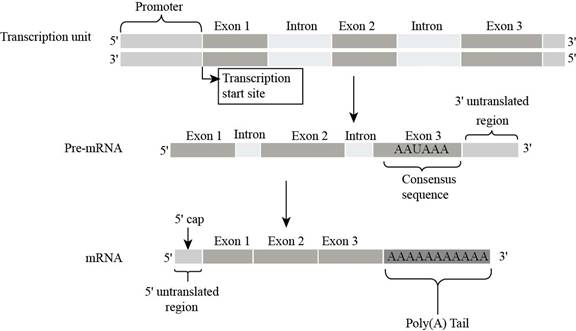
Fig. 4: Transcription start site
The actual site from where the transcription initiation occurs on the DNA template, is termed as transcription start site.
In figure transcription start site present within the starting of exon 1 on DNA strand.
e.
To determine:
The typical eukaryotic gene and the
Introduction:
The typical eukaryotic gene consists of an exon, intron, promoter sequence, a terminator sequence, upstream sequence, downstream sequence, enhancer,and silencer. A eukaryotic gene transcribes in
e.
Explanation of Solution
Pictorial representation:
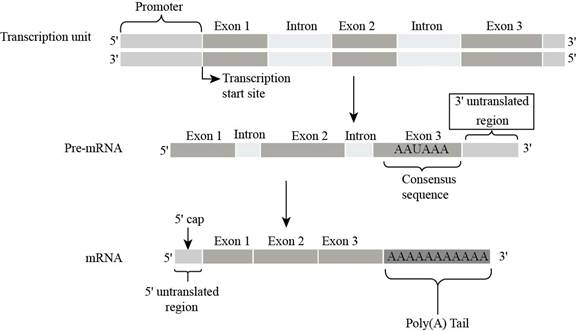
Fig. 5:
The
In the figure
f.
To determine:
The typical eukaryotic gene and the
Introduction:
The typical eukaryotic gene consists of an exon, intron, promoter sequence, a terminator sequence, upstream sequence, downstream sequence, enhancer,and silencer. A eukaryotic gene transcribes in
f.
Explanation of Solution
Pictorial representation:
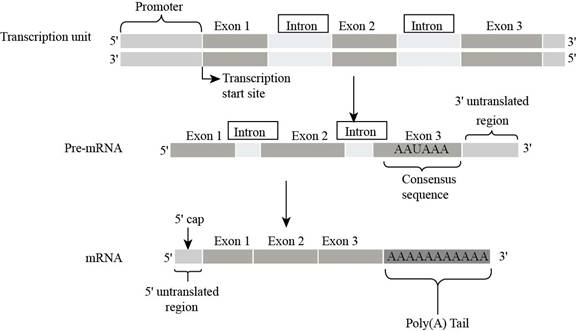
Fig. 6: Introns
DNA contains a particular sequence of
Introns are present in-between the coding sequence (gene) of DNA. Introns are transcribed and produce, but during the splicing process of RNA transcript, the intron segment is eliminated, hence do not code proteins.
In the figure, one intronsis present exon1 and exon2, and second introns are present in between exon 2 and exon 3, on DNA and
g.
To determine:
The typical eukaryotic gene and the
Introduction:
The typical eukaryotic gene consists of exon, intron, promoter sequence, terminator sequence, upstream sequence, downstream sequence, enhancer and silencer. A eukaryotic gene transcribe in
g.
Explanation of Solution
Pictorial representation:
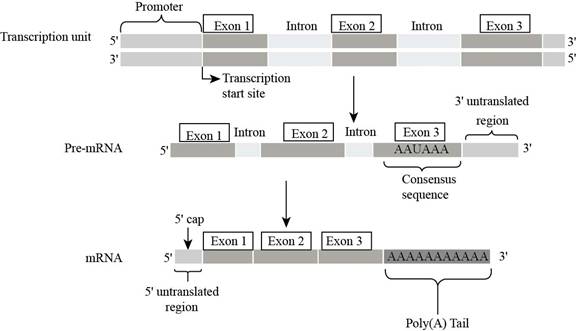
Fig. 7: Exons.
DNA contains a particular sequence of nucleotide which codes for a particular protein, termed as gene. Gene contains the coding regions which codes a particular functional protein is termed as exon.
In the figure, coding sequences marked as exon1, exon 2 , and exon 3, on DNA
h.
To determine:
The typical eukaryotic gene and the
Introduction:
The typical eukaryotic gene consists of exon, intron, promoter sequence, terminator sequence, upstream sequence, downstream sequence, enhancer and silencer. A eukaryotic gene transcribe in
h.
Explanation of Solution
Pictorial representation:
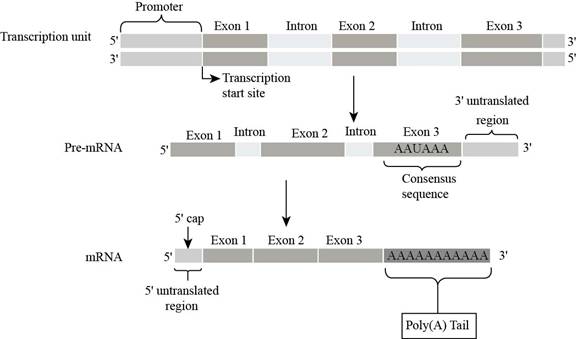
Fig. 8: Poly (A) tail
Eukaryotic
In the figure, poly (A) tail present on the
i.
To determine:
The typical eukaryotic gene and the
Introduction:
The typical eukaryotic gene consists of exon, intron, promoter sequence, terminator sequence, upstream sequence, downstream sequence, enhancer and silencer. A eukaryotic gene transcribe in
i.
Explanation of Solution
Pictorial representation:
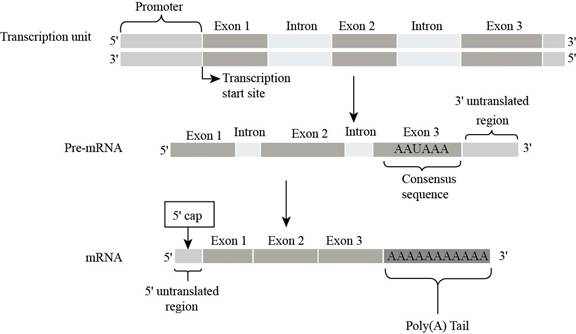
Fig. 9:
Eukaryotic
In the figure,
Want to see more full solutions like this?
Chapter 14 Solutions
Genetics
- ✓ Details Draw a protein that is embedded in a membrane (a transmembrane protein), label the lipid bilayer and the protein. Identify the areas of the lipid bilayer that are hydrophobic and hydrophilic. Draw a membrane with two transporters: a proton pump transporter that uses ATP to generate a proton gradient, and a second transporter that moves glucose by secondary active transport (cartoon-like is ok). It will be important to show protons moving in the correct direction, and that the transporter that is powered by secondary active transport is logically related to the proton pump.arrow_forwarddrawing chemical structure of ATP. please draw in and label whats asked. Thank you.arrow_forwardOutline the negative feedback loop that allows us to maintain a healthy water concentration in our blood. You may use diagram if you wisharrow_forward
- Give examples of fat soluble and non-fat soluble hormonesarrow_forwardJust click view full document and register so you can see the whole document. how do i access this. following from the previous question; https://www.bartleby.com/questions-and-answers/hi-hi-with-this-unit-assessment-psy4406-tp4-report-assessment-material-case-stydu-ms-alecia-moore.-o/5e09906a-5101-4297-a8f7-49449b0bb5a7. on Google this image comes up and i have signed/ payed for the service and unable to access the full document. are you able to copy and past to this response. please see the screenshot from google page. unfortunality its not allowing me attch the image can you please show me the mathmetic calculation/ workout for the reult sectionarrow_forwardIn tabular form, differentiate between reversible and irreversible cell injury.arrow_forward
- 1.)What cross will result in half homozygous dominant offspring and half heterozygous offspring? 2.) What cross will result in all heterozygous offspring?arrow_forward1.Steroids like testosterone and estrogen are nonpolar and large (~18 carbons). Steroids diffuse through membranes without transporters. Compare and contrast the remaining substances and circle the three substances that can diffuse through a membrane the fastest, without a transporter. Put a square around the other substance that can also diffuse through a membrane (1000x slower but also without a transporter). Molecule Steroid H+ CO₂ Glucose (C6H12O6) H₂O Na+ N₂ Size (Small/Big) Big Nonpolar/Polar/ Nonpolar lonizedarrow_forwardwhat are the answer from the bookarrow_forward
 Human Anatomy & Physiology (11th Edition)BiologyISBN:9780134580999Author:Elaine N. Marieb, Katja N. HoehnPublisher:PEARSON
Human Anatomy & Physiology (11th Edition)BiologyISBN:9780134580999Author:Elaine N. Marieb, Katja N. HoehnPublisher:PEARSON Biology 2eBiologyISBN:9781947172517Author:Matthew Douglas, Jung Choi, Mary Ann ClarkPublisher:OpenStax
Biology 2eBiologyISBN:9781947172517Author:Matthew Douglas, Jung Choi, Mary Ann ClarkPublisher:OpenStax Anatomy & PhysiologyBiologyISBN:9781259398629Author:McKinley, Michael P., O'loughlin, Valerie Dean, Bidle, Theresa StouterPublisher:Mcgraw Hill Education,
Anatomy & PhysiologyBiologyISBN:9781259398629Author:McKinley, Michael P., O'loughlin, Valerie Dean, Bidle, Theresa StouterPublisher:Mcgraw Hill Education, Molecular Biology of the Cell (Sixth Edition)BiologyISBN:9780815344322Author:Bruce Alberts, Alexander D. Johnson, Julian Lewis, David Morgan, Martin Raff, Keith Roberts, Peter WalterPublisher:W. W. Norton & Company
Molecular Biology of the Cell (Sixth Edition)BiologyISBN:9780815344322Author:Bruce Alberts, Alexander D. Johnson, Julian Lewis, David Morgan, Martin Raff, Keith Roberts, Peter WalterPublisher:W. W. Norton & Company Laboratory Manual For Human Anatomy & PhysiologyBiologyISBN:9781260159363Author:Martin, Terry R., Prentice-craver, CynthiaPublisher:McGraw-Hill Publishing Co.
Laboratory Manual For Human Anatomy & PhysiologyBiologyISBN:9781260159363Author:Martin, Terry R., Prentice-craver, CynthiaPublisher:McGraw-Hill Publishing Co. Inquiry Into Life (16th Edition)BiologyISBN:9781260231700Author:Sylvia S. Mader, Michael WindelspechtPublisher:McGraw Hill Education
Inquiry Into Life (16th Edition)BiologyISBN:9781260231700Author:Sylvia S. Mader, Michael WindelspechtPublisher:McGraw Hill Education





